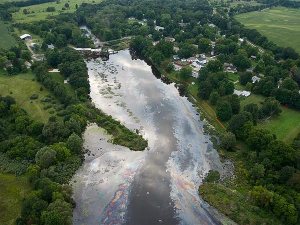Since the Kalamazoo River tar sands (heavy crude) oil spill three years ago, there has been overwhelming evidence that not all crude oils are equal, despite what Enbridge and PHMSA would lead you to believe. I started to really question this point, from a regulatory perspective, after learning that A) Line 6b had been switched to a tar sands pipeline without public notice and B) after clean up crews discovered that most of the tar sands oil in the Kalamazoo River has ended up on the bottom of the river because heavy crude sinks vs. floats.
My last point is one that Enbridge, to this day, disputes -which is incredible considering they are still trying to figure out how to clean up the Kalamazoo River because of submerged oil. My take on this is they believe if you say something over and over and over again, the public is stupid enough to believe it and perhaps they remove themselves of some liability (and brainwash their employees). Either way, as George Santayana said “those who do not remember the past are condemned to repeat it!” The frightening piece to that fact is that it’s people, wildlife and natural resources that will are left in the wake of their next disaster, and not Enbridge. Enbridge has proven that despite the largest and most costly inland oil spill in history, they can get away with expanding business and turn major profits.
I’ve digressed.
Back to my point, the latest SMH (shake my head) moment on this issue came after reading Lorraine Little’s response in the Detroit Free Press news story where Congressional members have demanded better transparency from Enbridge and PHMSA on the Mackinac Pipeline. In that story, Lorraine says this:
The increase in capacity is “relatively minor” and noted that the pipeline “does not now and never has carried heavy crude.”
The problem I have with this point is that Enbridge (and PHMSA for that matter) continue to talk out of both sides of their mouth. In order for Enbridge to make people feel better about the massive tar sands pipeline expansions flooding our region, they say crude is crude and tar sands oil floats. But when defending the safety of Line 5, which runs under one of the most sensitive locations in the world, they say things like the above.
What’s incredibly ironic about this is that Line 5 does in fact carry heavier crude that they’ve labeled as “sour”.. again, another name game to confuse you. With all that being said – how do you feel about the smoke and mirrors that’s before you, before our decision makers and before our regulators?
In addition, the devil is in the details. Looking back at the regulation, again, you should note that if Enbridge were to switch to a heavy crude on any of their pipelines, no notification would have to go to the public. Enbridge could push a batch of heavy crude through line 5 this afternoon and you would have no idea, nor would our regulators because crude is crude as far as they are concerned.
As I’ve already pointed out, PHMSA seems more than willing to continue playing the same game as industry. They have refused to acknowledge the difference, despite the real life lab study of the Kalamazoo River, and have sat on their hands for the past three years all while more and more tar sands pipeline projects overwhelm the U.S. The EPA, on the other hand, has taken some steps to pass along the lessons learned from the Kalamazoo River response and warned the State Department that Keystone XL needs special attention because it is a tar sands pipeline – their public advocacy on this point has stopped there.
The National Wildlife Federation is pushing to make some swift change on this issue through a rulemaking petition to both the EPA and PHMSA calling for tar sands pipeline safety regulations. Sadly, both agencies have not moved on our request and tar sands pipeline projects are speeding ahead at record pace.
We need to get some more momentum in the Great Lakes on this issue because we are already the hub for transportation of tar sands oil. Please consider writing the Department of State to tell them to deny the Alberta Clipper tar sands pipeline expansion until tar sands pipeline safety efforts are in place. Also, consider making a year-end tax delectable donation to the Great Lakes Regional Center of the National Wildlife Federation so I can continue to push this issue along.

The now infamous oil samples that Enbridge shops around to communities with the goal to show that crude is crude.
Related articles
- Citizens across the nation unite around protecting the Great Lakes from the Mackinac Pipeline (surfgreatlakes.wordpress.com)
- Safety Of Enbridge Pipeline In Great Lakes Challenged By Michigan And Illinois Senators (stunningguidance.wordpress.com)
- Are the Great Lakes the new transport lane for Alberta crude oil? (business.financialpost.com)
- Huge upswing in crude oil shipments on the Great Lakes from Canadian tar sands crude may be coming (eclectablog.com)



